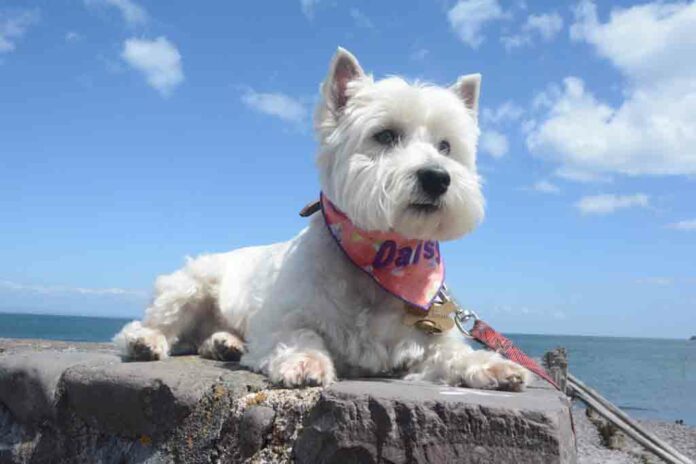… and Shelly too
On our holiday to Devon and Cornwall two years ago, we were struck by how dog-friendly everywhere was, so we made up our minds that we’d come back some day with Daisy, our West Highland Terrier.
Some day turned out to be last month, as we sailed again to the South of England. Ford provided an S-Max this time, a fine choice, with extra space and plenty of comfort. Not only had we all of Daisy’s stuff to bring, but my wife, Shelly, is by no means a light packer, so even starting off, we were fairly well loaded.
[doptg id=”29″]
We chose to travel with Irish Ferries on their Swift Service, as it involves a journey time of just two hours. Daisy would have to travel in a kennel on the car deck, so we wanted to minimise the journey time.
It was terrible having to put her into the kennel and lock the door but we just had to ignore the barks from herself and her travelling companions and head upstairs.
She was none the worse for wear when we collected her two hours later and after a few minutes, we were on Welsh soil on Holyhead. We found a large field outside the town and gave Daisy her first run on foreign ground before the journey South.
Although it’s a fair hike down to Devon, it’s mostly motorway or dual carriageway and if you can avoid rush hour, generally the traffic flows well and you can make progress.
Our destination was the tiny hamlet of East Anstey, outside the not much bigger village of Dulverton in North Devon. We were staying in self-catering accommodation at Knapp House, which previously was one of those tiny boarding schools you find dotted all around England. It was quiet and peaceful and a perfect base to explore Devon and parts of Somerset.
Once we got settled, it was time to find somewhere to eat and we had already decided to try the Bridge Inn, as we knew they were dog-friendly. Like many English pubs, they serve very good grub and we ate there several times over the week. I can particularly recommend the venison pie, matched with a pint of one of the excellent local ales.
The following morning, we decided on an easy day after our long trip down from Wales so after a quick trip into Barnstaple, one of the larger towns in North Devon, we headed for the coast.
On the way, we came across one of the many steam trains that operate around Devon. Aimed at tourists, they generally run for short distances along a scenic route. This particular one was supposed to run between Barnstaple and our intended destination, the town of Lynton. At the moment, though, the track is being refurbished, so it only runs over two miles of track. We reckoned we’d pass on this one.
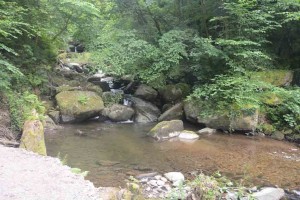
We arrived in Lynton but drove on to its twin town of Lynmouth. The two towns are situated side by side, but they’re separated by a cliff. In Victorian times, a seawater-powered funicular railway was built to provide transport between the two towns and it’s still in use today.
Lynmouth is a very pretty village by the sea and it’s also home to the Glen Lyn Gorge, which over the course of a short walk up a cliff, demonstrates the power of water in its many facets. There are water spouts to play with, demonstrations of hydro electric power generation and an exhibition detailing the devastation of the floods in 1952. It’s an interesting place to visit and very, very scenic.
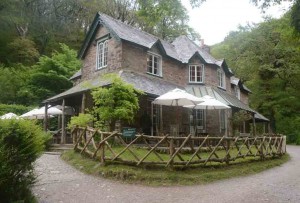
We followed signs to Watersmeet, which is only a mile or so outside the town and discovered the most beautiful wooded valley, where two rivers join to become one. The National Trust run a tea room there and we stopped for a cuppa. A slice of cherry pie had my name on it so I had my dessert before dinner and it was delicious.
It was back to Lynmouth to find an eating house and it seems to be an unwritten rule that each town or village must have a pub called the Rising Sun. The Rising Sun in Lynmouth came well recommended by a local and we had some first rate fish to finish a very relaxing day.
The following day, we decided to visit the Fleet Air Arm Museum as we had seen signs to it on the Motorway near Exeter. In my innocence, I though it was just off the motorway, but it turned out to be 40 minutes further on.
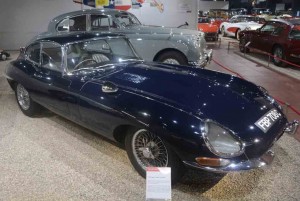
We arrived but even before we got in, we were told very snottily that dogs weren’t allowed. It was their attitude that put us off, so we went on to the nearby Haynes Motor Museum. Yes, the same Haynes who publish the workshop manuals. Housed in a modern building that looks like a large warehouse, the museum houses a higgledy-piggledy but very impressive collection of cars from many eras. They don’t allow dogs either, but they were nice about it, so we took turns going in and spent an enjoyable hour or two there. Well worth a visit.
On our way home, we called briefly into the village of Porlock, but by this stage in the evening, everywhere was closed so we headed back. On the way back, we climbed Porlock Hill, a section of road that rises into Exmoor at the rate of 400m in less than 3 km. In the early days of motoring, cars were tested on Porlock Hill. If your car could handle the hill, it was a good one. The S-Max easily handled the gradient in 3rd, but there’s also a less steep toll road for the more timid.
We were determined for most of our holiday to visit places we had never been before, but we just had to visit Appledore the following day.
Famous for shipbuilding, the Irish Navy had a ship built there recently. Despite the industrial activity, it’s a really pretty village on the mouth of the River Torridge, with meandering pedestrianised streets peppered with art and craft shops and a lovely riverside aspect.
We bought the makings of a picnic from John’s of Appledore, a well-known deli in the town and ate it on a sun drenched bench looking out over the river. Heavenly.
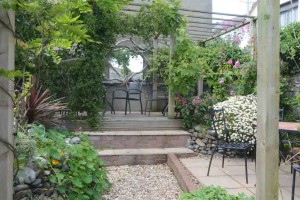
Later, strolling through the town, we came across Susie’s tearoom and stopped for another cuppa. The tearoom looked just like any normal terraced house but at the back was a beautifully landscaped garden with tables and chairs dotted around. A real suntrap and a real find.
Afterwards, we toured the Hartland Peninsula and enjoyed some spectacular views. At Hartland Point, you can look down and see the remains of a Dutch ship that went aground in 1982.
We went on to Clovelly, probably the most beautiful village I’ve ever been in. The village is privately owned and consists mainly of a narrow, cobbled, pedestrianised street that winds down to a gorgeous, secluded harbour. Daisy encountered many cats here, but she behaved herself impeccably and didn’t let us down by chasing them.
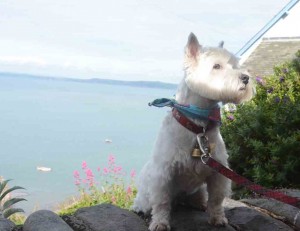
We had a drink half way down in a little tea room with a terrace overlooking the harbour. If you’re a fan of the Fry/Laurie Jeeves and Wooster TV series, you’ll have seen the same terrace in the episode where Bertie attempts to learn the Trombone. Thankfully there was no caterwauling on this occasion.
It must have been the long walk down into Clovelly and especially the even longer walk back up but Daisy was flaked out after the day and spent much of the next two days sleeping as much as she could.
The next day, we paid a visit to Sidmouth, a little town that started off life as a fishing village. Failed attempts to construct a harbour meant that its growth as a port was stymied so instead, it became a resort in the Georgian and Victorian periods. You can still feel the grandeur and there were some classy shops and restaurants, although not all of them were dog-friendly.
We ate while a heavy shower raged outside, one of the few times it rained properly during our holiday. Later, I was wandering around a bookshop when one of the assistants came over with biscuits for Daisy. Everywhere we went in fact, Daisy was the centre of attention. Not a day went by but she was admired many times over. It’s a wonder she didn’t get a swelled head.
We moved down the coast then to Lyme Regis, which I wanted to see mainly because it featured in the French Lieutenant’s Woman. Another Victorian era resort, it’s a really classy small town that’s nicknamed “The Pearl of Dorset”. It’s also known for the fossils found on the beach and for its cliffs, part of the Jurassic Coast, which is a World Heritage site.
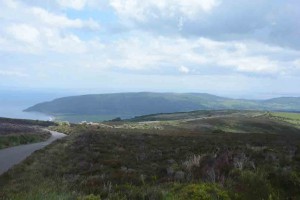
A stunning view down to the sea from the top of Exmoor.
We went back to Porlock the following day, driving across the top of Exmoor. The view down to the sea was truly spectacular so we stopped to take pictures.
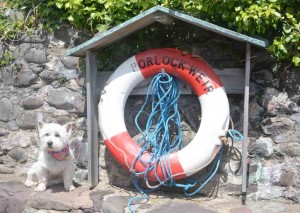
Our first port of call was Porlock Weir, which proved not to be so much a Weir as a harbour. A tiny little place, nevertheless it was beautiful in the sunlight and we enjoyed a tea and coffee with a slice of home-made cake at the Harbour Gallery and Café overlooking the picturesque little port.
It was onto Minehead then, which is a fairly substantial town. Not the prettiest perhaps, but it’s at the start of the Minehead steam railway and we decided to take a return trip to the fishing port of Watchett, about half an hour down the coast.
We had to buy a ticket for Daisy, but she took to train travel like a duck to water, being very relaxed as we chuffed along. Because of the timetables, we had about two hours to spend in Watchett before we could catch our return train.
As it turns out, ten minutes would have been sufficient. There really wasn’t a lot to see there and despite it being described in the guidebooks as a historic port village, I really couldn’t see the attraction. I’d give it a miss to be honest.
Finally, we got back to our car, drove to Porlock and had a proper look around. I’d read that the Victorian tearooms there was one of the places to go for an authentic cream tea, but wouldn’t you know our luck – they’re closed two days a week and this was one of their days to close.
I also came across an interesting little museum, although it wasn’t quite finished so I wasn’t allowed to have a proper look around. There were a few vintage cars in the process of being restored and the plan is to have these on display in addition to various interesting hoojahs of particular interest to the male of the species. A sort of man shed is the plan and I think it would be well worth a visit once it opens in a few weeks time.
Friday found us heading to Exeter, a substantial city, but one that hasn’t lost its character. Not only does it have the river running through it with walks and places to eat, it also has the most beautiful Cathedral with a square surrounding it, just off the main street.
There are several choices for eating al fresco and Daisy and I sat down and enjoyed an iced coffee while Shelly went shopping.
We went on then to another of our old haunts, Otterton Mill, where they do what’s reputed to be the best Cream Tea in Devon. I haven’t tried all available options but I can confirm that Otterton’s Cream Tea is first rate and as good as ever.
Our next stop was Exmouth, chosen solely because it was by the coast and unfortunately it turned out to be a bit of a disappointment, with nothing much to recommend it.
I saved the day, though, as on the drive in, I noticed a sign for a place called the Darts Farm Shop. When we arrived there, it turned out to be a posh interiors shop with a lovely café where I whiled away a pleasant hour reading as Shelly whizzed around the various shops having a whale of a time.
My good karma continued when I suggested a stop in the nearby town of Topsham. We discovered a lovely, classy riverside town with some really nice shops and a lovely feel about it. A real find.

This was our final evening around Dulverton and we chose to eat at Woods Bar and Restaurant in the village. We had eaten there a few times during the week and at this stage were being treated like locals. Two resident dogs in the bar barked at everything that moved but Daisy, as usual, took no notice, looking on disdainfully as she took her place under the table.
Woods is a lovely, old-fashioned local pub with attached restaurant and the food is really lovely. On our first night, I had John Dory, served on a bed of crushed potatoes and Shelly was so envious of my dish, she chose it the following night. I can also attest to the quality of their steak and Shelly reckons they also do the best Crème brûlée she’s ever tasted.
As we were leaving, we chatted with some of the locals enjoying the evening sun outside. As usual, Daisy was the centre of attention and her bandannas attracted particular comment. She had a different one for every day of the holiday. She was better dressed than myself.
As we were going down to Cornwall the following day, I was told not to miss Constantine Bay, near Padstow. Remote and little-known, but incredibly beautiful I was informed.
The next morning, we said a last farewell to Dulverton with a visit to Tantivy, a café and shop in the village. They have the most incredible selection of local beers, so I bought a few, including some Christmas Reinbeers. I’ll be looking forward to drinking them in December.
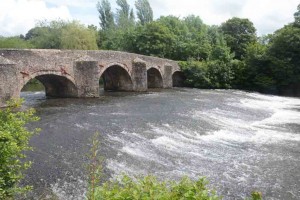
Rather than belting down to Cornwall, we decided to take a meandering path and stop whenever we felt like it, starting with a little sojurn at The Fisherman’s Cot, in Bickleigh, near Tiverton. We stopped solely because of its beautiful situation with a garden overlooking an old stone bridge on a little weir. We weren’t very hungry, so we just split a sandwich – a real doorstep of a job. If we weren’t on a schedule, I’d have been perfectly happy to stay there for the afternoon.
For our second week, we were staying just outside St Austell, at a place called Bosinver Farm Cottages, a delightful spot with ducks, chickens, geese, goats, rabbits and two very friendly horses running around the place. Daisy didn’t know where to look. It would suit families perfectly, with a range of accommodation available and it’s very safe and quiet.
We were hungry, so our first piece of business was to find somewhere to eat. The Polgooth Inn came highly recommended and was only down the road, so off we went.
Polgooth was another place we ended up visiting regularly. I can really recommend their Boar burger, possibly the best burger I’ve ever tasted, but it isn’t on the regular menu.

On the following day, Sunday, we decided on a trip to the Lost Gardens of Heligan. Now I’m not much of a one for gardens, but the story behind these gardens is fascinating.
Abandoned at the beginning of the 20th century, they were ‘rediscovered’ after a devastating hurricane in 1990. At this point they were completely overgrown and the reason behind their loss was discovered on an inscription etched into a limestone wall. It was signed by all those working in the gardens at the time and the date was August 1914.
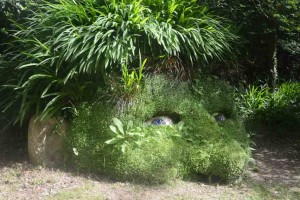
For some reason, I was expecting formal gardens, but there’s a delightful mix of mainly vegetable gardens, woodland walks and a jungle. There’s even a recreation of a dung-heated greenhouse for the ultimate in eco-technology. It was a great way to pass the day.
The next day, we went to Fowey, a little fishing port and then took a ferry to Polperro. Five minutes on the ferry saved a drive of perhaps an hour and these little ferries are dotted all around the coast. They’re well worth looking out for.
Polperro is car-free and you can either walk down to the village or take a little electric bus from the main car park. We took the bus which was great fun and is a good idea, particularly for the walk back up.
I asked at a local shop and was told that the Blue Peter was a good bet for lunch. So it proved. One of the specials was Pork chops with new Devon potatoes and they really were delicious. If you go there, have a look in the ladies’ loo upstairs and please don’t ask me how I know that!
We went on to another little port, Looe, where I discovered a little shop selling all sorts of cartoons and artwork, all featuring cats. You could happily while away an hour there.
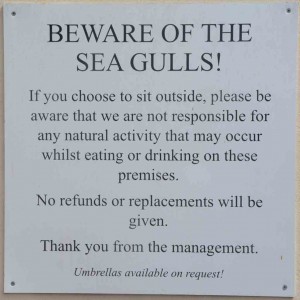
Before we left, we came across a really posh-looking local ice cream shop and I chose a lemon meringue/turkish delight combination. I had only stepped outside into the street and taken my first lick when there was a flash of white in front of my eyes and a split second later, a seagull had stolen most of my lovely ice cream.
Shelly heard me cursing and turned back a fraction too late to see the whole thing. She tells me I looked like a lost child, holding what was left of my cone before flinging it at the gulls with a ‘Take the rest of it, ye bastards!’ Then, of course, I had to do the walk of shame back to the shop to get another ice cream. In fairness to them, they didn’t laugh, at least while I was still in the shop.
The next day, still traumatised over ice creamgate, we went back up North towards Tavistock, an unusual small town with a covered market inside a castle. The market is permanent and it’s joined by different outdoor markets depending on the day.
We went on then to Saltash, across the Tamar Bridge from Plymouth, but we didn’t like the look of it so didn’t even stop. We had to go back over the bridge and this time were caught for the toll, but it’s only £1.50.
Since Saltash was a washout, we made an executive decision to explore the headland around Rame Head. To save ourself a bit of a drive, we headed back into Plymouth to get a ferry across the river to Torpoint. The fare for this was also £1.50 but nobody came to collect, so it all evened out in the end.
We spent the rest of the day driving around the headland, enjoying spectacular views out onto the water. We stopped at the Clifftop Cafe, which is actually built on the cliffs and commands a great view out to sea. They were serving a delicious looking all day breakfast, which tempted us greatly, but we moved on and had a picnic down the coast.
We were joined at our bench by a shaggy sheepdog who came barrelling up with a tennis ball in her mouth. She looked so doleful that I had to give her part of my sandwich, much to Daisy’s disgust. Before we left, we had a game of fetch and I’m sure I’d still be there if she had any say in the matter.
We went back to Polgooth that night to dine, only to discover that Tuesday is Tapas night. With three plates for just £10 we had a choice of some delicious food for very little money. Tuesday is also Table Quiz night but we decided to give it a miss. It’s worth going on Tuesdays for the Tapas though.
On Wednesday morning, we stayed around Bosinver to feed the livestock. It started with the poultry, who were eager to peck grain from our hands but it really only became manic when they were joined by the goats. Even the sheep got in on the act, although they were fenced off in a field. It was great craic entirely.
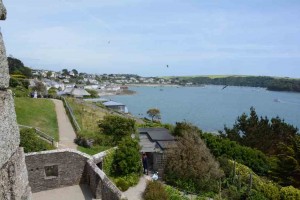
We then went on to visit St Mawes, which features an impressive castle built by Henry VIII to defend against the Spanish Armadas. The castle is very well preserved and the full history is imparted with hand held audio guides. The story of the place proved fascinating and the Castle even played a role in defence during the second world war.
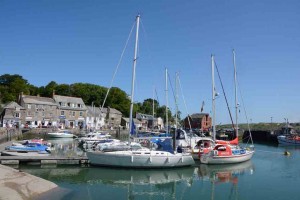
With our holiday nearing its last days, we decided to pay a return visit to Padstow, which is a really pretty port and home of Rick Stein’s food empire. We couldn’t go to the restaurant this time, so even though we already had our sandwiches made for the picnic, we split one of his Cornish Pasties. Trying to be good, we chose a cheese and onion variety, on the basis that it would be lighter than a more traditional beef filling. Once we tasted it, we were sorry we didn’t buy one each but a huge fruit filled meringue more than made up for our disappointment.

Daisy enjoys the beach at Constantine Bay.
After our lunch, we went on to visit Constantine Bay, the built-in satnav making it ridiculously easy to find. It was every bit as beautiful as we had been led to believe and Daisy had a great time running around on the golden sand. We even got her to join us in a little paddle, although I reckon the water is far too cold to enjoy a swim.
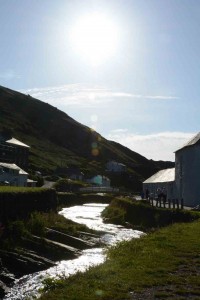
It was on then to Boscastle, to visit another of our old haunts, the Riverside, where two years ago, Shelly discovered she loved scallops. They were as good as ever but we had to eat outside in the garden as dogs aren’t allowed in the evenings. It was no hardship as by now, the weather, which at the beginning of the holiday was dryish but a bit dull, had morphed into beautiful blue skies and high temperatures. It proved to be a very pleasant end to the day – and to the holiday really, as the following day we were going to head back towards the ferry.
Rather than doing it all in one day, we decided to spend our last night in Wales so we wouldn’t have too far to travel to reach Holyhead.
Before we left St Austell, we had a very important job to do and that was to get Daisy checked by a vet and treated for ticks and fleas. It’s part of the pet passport scheme that allows animals to move across borders without quarantine. A bit of a nuisance, but I suppose it’s necessary.
On the way up the motorway, we wanted to stop somewhere for a last picnic and Shelly, looking at the map, noticed a lake coming up just north of Launceston.
We reckoned it looked promising and so it proved. Only five minutes off the motorway, Roadford Lake is run by a charity trust and there are walking and cycling trails if you’re feeling energetic.
We were more interested in having our picnic and following it up with a last ice cream while keeping a watchful eye out for seagulls.
Our last night was spent in Pen-y-Dyffryn Hotel, in the countryside outside Oswestry in Shropshire. We had spent longer than we intended in Exeter on our way up, so we arrived with less than half an hour to check in, get dressed and get Daisy fed and watered before our dinner reservation at 8.30.
We made it with seconds to spare and it was well worth the rush. We started with Pea mousse on toast with pancetta, olives and an onion bhajee and those were just served as an amuse bouche.
For mains, we both chose the duck, served pink, as recommended by the chef and it proved to be a wise choice. It was really wonderful.
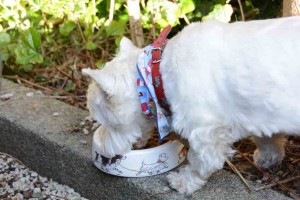
Daisy was allowed to join us in the lounge afterwards for a Welsh coffee to round off the meal. Incidentally, a Welsh coffee is the same as an Irish coffee, only they cheat by using clotted cream.
A delicious breakfast on the terrace the following morning set us up for our final journey back to Holyhead.
When we arrived at the port, I had the unusual experience of being breathalysed for the first time ever in my driving career. Even though I’d had a few drinks the night before, I knew I was perfectly fine. So it proved, the device registering zero on both tries. It’s comforting to know that drink driving is being taken seriously.
I’d recommend the holiday to anyone. Devon and Cornwall are beautiful and I don’t think I’ve ever had a more relaxing time.
We last went to Devon and Cornwall in 2012. Click to read To St Ives in an E-Type.
Motoring editor - The Clare Champion
Former Chairman and voting member of Irish Motoring Writers' Association


